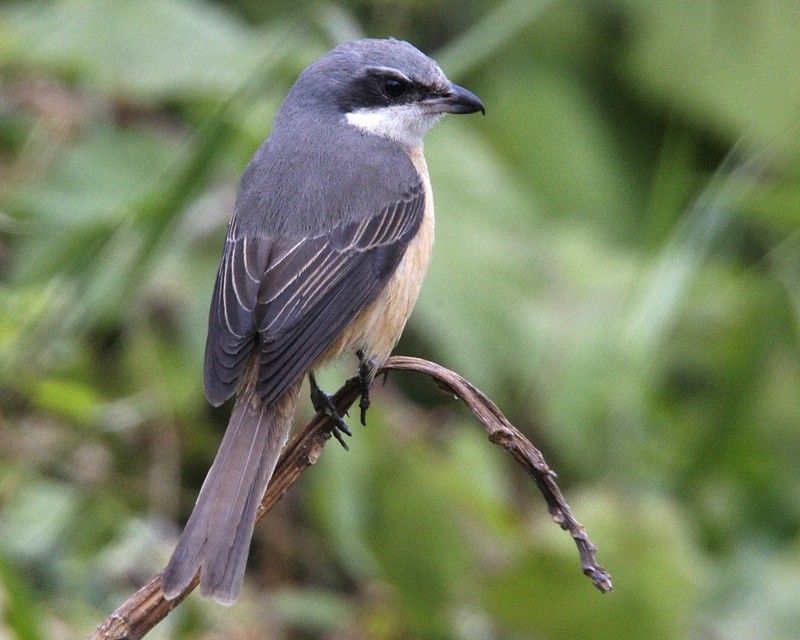Grey-backed Shrike
A species of Typical shrikes Scientific name : Lanius tephronotus Genus : Typical shrikes
Grey-backed Shrike, A species of Typical shrikes
Botanical name: Lanius tephronotus
Genus: Typical shrikes
Content
Description General Info
 Photo By Lip Kee , used under CC-BY-SA-2.0 /Cropped and compressed from original
Photo By Lip Kee , used under CC-BY-SA-2.0 /Cropped and compressed from original Description
The species is 21–25 cm long and weighs 39-54 g. It is a shrike with long tail. The nominate race has black lowermost forehead (just over base of bill) and facial mask through lores and eye to rear ear-coverts; crown to nape and most of upperparts dark grey, small rufous rump patch; upperwing black, most wing-coverts, secondaries and tertials fringed pale rufous to whitish, sometimes tiny white patch at base of primaries (often lacking); tail chestnut-brown, tipped buffish, outermost pair of rectrices light brown; throat and undertail brownish-grey; iris dark brown; bill black or dark green; legs dull black or dark green. Sexes very similar. Juvenile is browner above than adult, with less marked brown (not black) facial mask, horn-colored lower mandible, has crown finely barred, upperparts and much of underparts heavily barred dark brownish. Race lahulensis is smaller and weaker-billed than nominate, also much paler, brownish-grey above, with rufous lower back and rump, white primary patch usually slightly larger and more visible, tail sometimes blackish (not brown). Voice: Rough, breathing-like call. Territorial call described as harsh zzert-zzert..., tchert-tchert... or tzert-tzert...; repertoire includes also a repeated ktcht-ktcht-ktcht given at dusk or as alarm. Breeding song subdued and musical, with mimicry of other bird calls lasting several minutes. Voice seems to be similar to that of L. schach. 
Size
23 cm
Nest Placement
Tree
Feeding Habits
Grey-backed Shrike primarily consumes insects like moths, beetles, and caterpillars, and occasionally small vertebrates. They exhibit a sit-and-wait hunting technique from perches, sometimes hawking insects mid-air. Notable for impaling prey for storage, grey-backed Shrike hunts within proximity to their nest during breeding season.
Habitat
Grey-backed Shrike thrives in high-elevation montane regions and plateaus of Central and South Asia, including forest clearings, plateau plains, and mountain meadows with shrubbery, up to 4500 meters. Beyond breeding, they adapt to young coniferous forests and high-altitude pastures. In the non-breeding season, their habitats vary from gardens to abandoned fields in valleys and plains.
Dite type
Carnivorous
General Info
Feeding Habits
Bird food type
Distribution Area
The grey-backed shrike has two subspecies. L. t. lahulensis (Koelz, 1950) breeds from north Kashmir east to central India (Uttar Pradesh), and southwest China. L. t. tephronotus (Vigors, 1831) breeding range extends from Nepal east to northeast India (Arunachal Pradesh), and center and south China (southern Gansu, Ningxia and eastern Shanxi south to southeast Qinghai, south and east Xizang, southeast Yunnan and central Guizhou); non-breeding distribution stretches south to Bangladesh, Myanmar, Thailand and Indochina. Breeds at high elevations in forest clearings, plateau plains and mountain meadows dotted with small trees or fairly large bushes; to at least 4500 m in Nepal (becoming common from 2700 m upwards) and in south China (Yunnan). Post-breeding habitat in Sichuan (south China) either young open coniferous stands with forest clearings dominated by bushes, or pastures at higher elevations; at lower altitudes occurs in extensive agricultural valleys near human settlements. On non-breeding grounds in valleys and plains found in variety of habitats, including gardens and abandoned cultivation. 
Species Status
Not globally threatened.
Scientific Classification
Phylum
Chordates Class
Birds Order
Perching birds Family
True shrikes Genus
Typical shrikes Species
Grey-backed Shrike